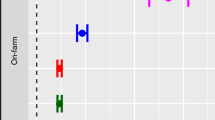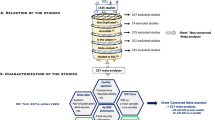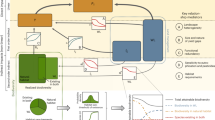Abstract
Ecological intensification (EI) could help return agriculture into a ‘safe operating space’ for humanity. Using a novel application of meta-analysis to data from 30 long-term experiments from Europe and Africa (comprising 25,565 yield records), we investigated how field-scale EI practices interact with each other, and with N fertilizer and tillage, in their effects on long-term crop yields. Here we confirmed that EI practices (specifically, increasing crop diversity and adding fertility crops and organic matter) have generally positive effects on the yield of staple crops. However, we show that EI practices have a largely substitutive interaction with N fertilizer, so that EI practices substantially increase yield at low N fertilizer doses but have minimal or no effect on yield at high N fertilizer doses. EI practices had comparable effects across different tillage intensities, and reducing tillage did not strongly affect yields.
This is a preview of subscription content, access via your institution
Access options
Access Nature and 54 other Nature Portfolio journals
Get Nature+, our best-value online-access subscription
$29.99 / 30 days
cancel any time
Subscribe to this journal
Receive 12 digital issues and online access to articles
$119.00 per year
only $9.92 per issue
Buy this article
- Purchase on Springer Link
- Instant access to full article PDF
Prices may be subject to local taxes which are calculated during checkout





Similar content being viewed by others
Data availability
The datasets analysed during the current study are available from the authors on reasonable request. Please contact the corresponding author for assistance. Data from LTEs belonging to Rothamsted Research are available on reasonable request via the e-RA platform (www.era.rothamsted.ac.uk). We have refrained from depositing data into a public repository due to the need for guidance to correctly interpret LTE designs and datasets and the need to ensure that the substantial investments by each institute in maintaining LTEs do not go unacknowledged when data are used.
Code availability
R scripts used in the analyses are also available from the corresponding author on reasonable request.
References
Rockström, J. et al. Sustainable intensification of agriculture for human prosperity and global sustainability. Ambio 46, 4–17 (2017).
Steffen, W. et al. Planetary boundaries: guiding human development on a changing planet. Science 347, 1259855 (2015).
Campbell, B. M. et al. Agriculture production as a major driver of the Earth system exceeding planetary boundaries. Ecol. Soc. 22, 8 (2017).
Hazell, P. & Wood, S. Drivers of change in global agriculture. Philos. Trans. R. Soc. B 363, 495–515 (2008).
Lehmann, P. et al. Complex responses of global insect pests to climate warming. Front. Ecol. Environ. 18, 141–150 (2020).
Foley, J. A. et al. Solutions for a cultivated planet. Nature 478, 337–342 (2011).
Springmann, M. et al. Options for keeping the food system within environmental limits. Nature 562, 519–525 (2018).
Hunter, M. C., Smith, R. G., Schipanski, M. E., Atwood, L. W. & Mortensen, D. A. Agriculture in 2050: recalibrating targets for sustainable intensification. Bioscience 67, 386–391 (2017).
Ecosystems and Human Well-being: Synthesis (Millenium Ecosystem Assessment, 2005); http://www.millenniumassessment.org/documents/document.356.aspx.pdf
Bommarco, R., Kleijn, D. & Potts, S. G. Ecological intensification: harnessing ecosystem services for food security. Trends Ecol. Evol. 28, 230–238 (2013).
Kleijn, D. et al. Ecological intensification: bridging the gap between science and practice. Trends Ecol. Evol. 34, 154–166 (2018).
Pingali, P. L. Green revolution: impacts, limits, and the path ahead. Proc. Natl Acad. Sci. USA 109, 12302–12308 (2012).
Wezel, A. et al. Agroecology as a science, a movement and a practice. Sustain. Agric. 2, 27–43 (2009).
Garnett, T. et al. Sustainable intensification in agriculture: premises and policies. Science 341, 33–34 (2013).
Lipper, L. et al. Climate-smart agriculture for food security. Nat. Clim. Change 4, 1068–1072 (2014).
Tittonell, P. Ecological intensification of agriculture—sustainable by nature. Curr. Opin. Environ. Sustain. 8, 53–61 (2014).
Jenkinson, D. S. The impact of humans on the nitrogen cycle, with focus on temperate arable agriculture. Plant Soil 228, 3–15 (2001).
Verheijen, F. G. A., Jones, R. J. A., Rickson, R. J. & Smith, C. J. Tolerable versus actual soil erosion rates in Europe. Earth Sci. Rev. 94, 23–38 (2009).
Peoples, M. B. et al. in Agroecosystem Diversity: Reconciling Contemporary Agriculture and Environmental Quality (eds Lemaire, G. et al.) 123–142 (Academic Press, 2019); https://doi.org/10.1016/B978-0-12-811050-8.00008-X
Storkey, J., Bruce, T., McMillan, V. & Neve, P. in Agroecosystem Diversity: Reconciling Contemporary Agriculture and Environmental Quality (eds Lemaire, G. et al.) 199–209 (Academic Press, 2019); https://doi.org/10.1016/B978-0-12-811050-8.00012-1
Schröder, J. Revisiting the agronomic benefits of manure: a correct assessment and exploitation of its fertilizer value spares the environment. Bioresour. Technol. 96, 253–261 (2005).
Mhlanga, B., Ercoli, L., Pellegrino, E., Onofri, A. & Thierfelder, C. The crucial role of mulch to enhance the stability and resilience of cropping systems in southern Africa. Agron. Sustain. Dev. 41, 29–43 (2021).
Barrett, C. B. & Bevis, L. E. M. The self-reinforcing feedback between low soil fertility and chronic poverty. Nat. Geosci. 8, 907–912 (2015).
Tittonell, P. & Giller, K. E. When yield gaps are poverty traps: the paradigm of ecological intensification in African smallholder agriculture. Field Crops Res. 143, 76–90 (2013).
Sandén, T. et al. European long-term field experiments: knowledge gained about alternative management practices. Soil Use Manage. 34, 167–176 (2018).
Storkey, J. et al. The unique contribution of Rothamsted to ecological research at large temporal scales. Adv. Ecol. Res. 55, 3–42 (2016).
Johnston, A. E. & Poulton, P. R. The importance of long-term experiments in agriculture: their management to ensure continued crop production and soil fertility; the Rothamsted experience. Eur. J. Soil Sci. 69, 113–125 (2018).
Bowles, T. M. et al. Long-term evidence shows that crop-rotation diversification increases agricultural resilience to adverse growing conditions in North America. One Earth 2, 284–293 (2020).
Marini, L. et al. Crop rotations sustain cereal yields under a changing climate. Environ. Res. Lett. 15, 124011 (2020).
Lal, R. Carbon emission from farm operations. Environ. Int. 30, 981–990 (2004).
Cordell, D., Drangert, J. O. & White, S. The story of phosphorus: global food security and food for thought. Glob. Environ. Change 19, 292–305 (2009).
Lechenet, M., Dessaint, F., Py, G., Makowski, D. & Munier-Jolain, N. Reducing pesticide use while preserving crop productivity and profitability on arable farms. Nat. Plants 3, 17008 (2017).
Bedoussac, L. et al. Ecological principles underlying the increase of productivity achieved by cereal-grain legume intercrops in organic farming. A review. Agron. Sustain. Dev. 35, 911–935 (2015).
Storkey, J., Mead, A., Addy, J. & MacDonald, A. J. Agricultural intensification and climate change have increased the threat from weeds. Glob. Change Biol. 27, 2416–2425 (2021).
Vanlauwe, B. et al. in Integrated Plant Nutrient Management in Sub-Saharan Africa: From Concept to Practice (eds Vanlauwe, B. et al.) 173–184 (CABI, 2002).
Hijbeek, R. et al. Do organic inputs matter—a meta-analysis of additional yield effects for arable crops in Europe. Plant Soil 411, 293–303 (2017).
Thierfelder, C. & Wall, P. C. Effects of conservation agriculture techniques on infiltration and soil water content in Zambia and Zimbabwe. Soil Tillage Res. 105, 217–227 (2009).
Gentile, R., Vanlauwe, B., Chivenge, P. & Six, J. Interactive effects from combining fertilizer and organic residue inputs on nitrogen transformations. Soil Biol. Biochem. 40, 2375–2384 (2008).
Mupangwa, W. et al. Maize yields from rotation and intercropping systems with different legumes under conservation agriculture in contrasting agro-ecologies. Agric. Ecosyst. Environ. 306, 107170 (2021).
Pittelkow, C. M. et al. Productivity limits and potentials of the principles of conservation agriculture. Nature 517, 365–368 (2015).
Steward, P. R. et al. The adaptive capacity of maize-based conservation agriculture systems to climate stress in tropical and subtropical environments: a meta-regression of yields. Agric. Ecosyst. Environ. 251, 194–202 (2018).
Pittelkow, C. M. et al. When does no-till yield more? A global meta-analysis. Field Crops Res. 183, 156–168 (2015).
Sun, W. et al. Climate drives global soil carbon sequestration and crop yield changes under conservation agriculture. Glob. Change Biol. 26, 3325–3335 (2020).
Kirkegaard, J. A. et al. Sense and nonsense in conservation agriculture: principles, pragmatism and productivity in Australian mixed farming systems. Agric. Ecosyst. Environ. 187, 133–145 (2014).
Thierfelder, C. et al. Complementary practices supporting conservation agriculture in southern Africa. A review. Agron. Sustain. Dev. 38, 16–37 (2018).
Alignier, A. et al. Configurational crop heterogeneity increases within-field plant diversity. J. Appl. Ecol. 57, 654–663 (2020).
Liebman, M. et al. Ecologically sustainable weed management: how do we get from proof-of-concept to adoption? Ecol. Appl. 26, 1352–1369 (2016).
Giller, K. E. The food security conundrum of sub-Saharan Africa. Glob. Food Sec. 26, 100431 (2020).
Bates, D., Maechler, M., Bolker, B. & Walker, S. Fitting linear mixed-effects models using lme4. J. Stat. Softw. 67, 1–48 (2015).
Addy, J. W. G., Ellis, R. H., Macdonald, A. J., Semenov, M. A. & Mead, A. Changes in agricultural climate in South-Eastern England from 1892 to 2016 and differences in cereal and permanent grassland yield. Agric. For. Meteorol. 308–309, 108560 (2021).
Bates, D., Kliegl, R., Vasishth, S. & Baayen, H. Parsimonious mixed models. Preprint at https://arXiv.org/abs/1506.04967v2 (2018).
MacLaren, C., Glendining, M., Poulton, P., Macdonald, A. & Clark, S. Woburn Ley-Arable Experiment: Yields of Wheat as First Test Crop, 1976–2018 (e-RA Rothamsted, 2022); https://doi.org/10.23637/wrn3-wheat7618-01 .
Lenth, R. emmeans: Estimated Marginal Means, aka Least-Squares Means: R package version 1.7.2 https://CRAN.R-project.org/package=emmeans (2020).
Viechtbauer, W. Conducting meta-analyses in R with the metafor package. J. Stat. Softw. 36, 1–48 (2010).
Lajeunesse, M. J. On the meta-analysis of response ratios for studies with correlated and multi-group designs. Ecology 92, 2049–2055 (2011).
Wickham, H. ggplot2: Elegant Graphics for Data Analysis (Springer-Verlag, 2016).
Crain, C. M., Kroeker, K. & Halpern, B. S. Interactive and cumulative effects of multiple human stressors in marine systems. Ecol. Lett. 11, 1304–1315 (2008).
Acknowledgements
The authors thank everyone who has been involved in designing, maintaining, funding, and collecting and managing data from all LTEs included in this study. We are grateful to the GLTEN (https://glten.org/), funded by the Thirty Percy Foundation for providing meta-data on the LTEs. The Rothamsted Long-term Experiments National Capability (LTE-NC) is supported by the UK BBSRC (BBS/E/C/000J0300) and the Lawes Agricultural Trust. LTEs belonging to SRUC are supported through Scottish Government RESAS Strategic Research Programme. C.M., J. Storkey, A.M. and L.C. were supported by the ‘GLTEN-Africa’ project (BB/R020663/1) funded by the Global Challenge Research Fund programme of the Biotechnology and Biological Sciences Research Council (BBSRC), and J. Six and A.M. also by the BBSRC Soils to Nutrition project (BBS/E/C/000I0320). For the purpose of open access, the authors have applied a Creative Commons Attribution (CC BY) licence to any Author Accepted Manuscript version arising.
Author information
Authors and Affiliations
Contributions
C.M., J. Storkey, A.M. and L.C. conceptualized this study. D.v.B., A.E., J.d.H., W.H., O.J., T.K., J.L., Å.M., M.N., G.N., J. Six, J. Strauss, P.A.S., C. Thierfelder, C. Topp, F.T., H.V., R.W., M.W. and C.W. were involved in the management and collection of data from LTEs included. C.M. and A.M. undertook the analysis with input from J. Storkey. C.M. wrote the manuscript with input from all authors.
Corresponding author
Ethics declarations
Competing interests
The authors declare no competing interests.
Peer review
Peer review information
Nature Sustainability thanks Michael Beckmann, Timothy Bowles, Sileshi Weldesemayat and the other, anonymous, reviewer(s) for their contribution to the peer review of this work.
Additional information
Publisher’s note Springer Nature remains neutral with regard to jurisdictional claims in published maps and institutional affiliations.
Supplementary information
Supplementary Information
Supplementary Parts 1–3, Figs. 1.1–3.5 and Tables 1.1–3.10.
Rights and permissions
About this article
Cite this article
MacLaren, C., Mead, A., van Balen, D. et al. Long-term evidence for ecological intensification as a pathway to sustainable agriculture. Nat Sustain 5, 770–779 (2022). https://doi.org/10.1038/s41893-022-00911-x
Received:
Accepted:
Published:
Issue Date:
DOI: https://doi.org/10.1038/s41893-022-00911-x
This article is cited by
-
Diversifying crop rotation increases food production, reduces net greenhouse gas emissions and improves soil health
Nature Communications (2024)
-
Maize yield under a changing climate in Uganda: long-term impacts for climate smart agriculture
Regional Environmental Change (2024)
-
Research on intercropping from 1995 to 2021: a worldwide bibliographic review
Plant and Soil (2024)
-
Spatially differentiated nitrogen supply is key in a global food–fertilizer price crisis
Nature Sustainability (2023)
-
Nitrogen fertilizer classification using multivariate fingerprinting with stable isotopes
Nutrient Cycling in Agroecosystems (2023)



